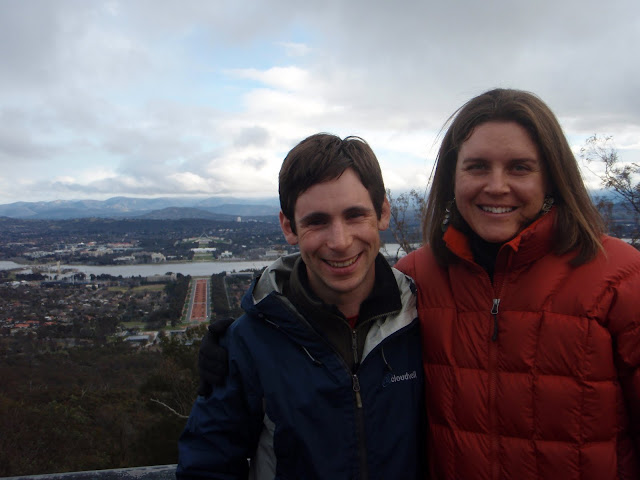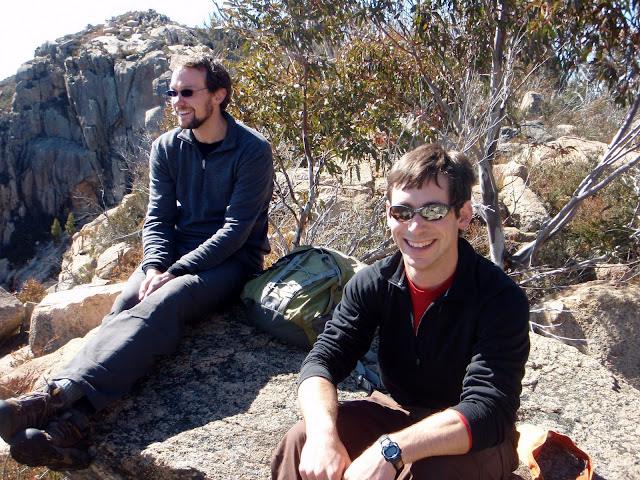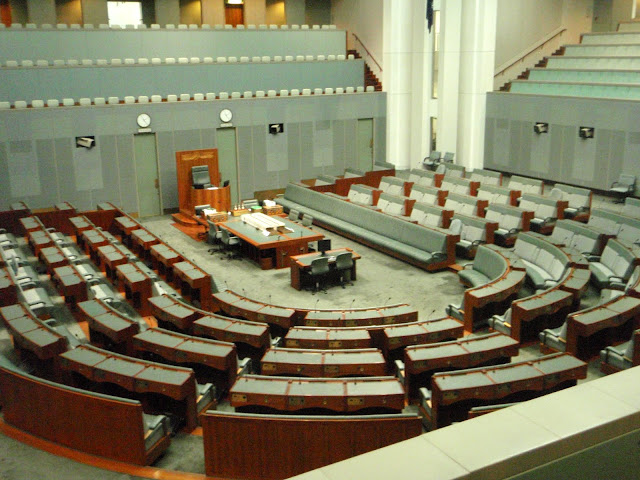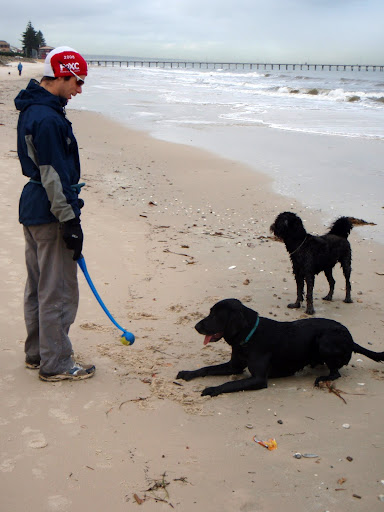Canberra feels like a capitol -- the architect (Walter Burley Griffin) was an American, and he definitely drew some of his inspiration from Washington D.C. Lots of monuments, lots of museums, lots of streets with funny names in funny configurations, lots of young professionals drawn from other parts of the country to run the government and its attendant structures. However, Canberra blends into its surroundings much better than any capitol city I have ever been to, containing large tracts of open un-manicured space and melting into the hills that surround it (this may have something to do with the fact that Burley Griffin was a student of Frank Lloyd Wright). In fact, Canberra surrounds and is built on several hills, reminiscent of another hilly capitol city.
Wednesday 8 September 2010
The Nation's Capital
For those of you who don’t know (and I certainly didn’t), Canberra is the capital of Australia. We’ve heard a variety of explanations for why Canberra is where it is (apart from Alice Springs, I think it’s the only major Australian city that’s not along the coast). I think the main consensus is that Sydney and Melbourne couldn’t agree about which should be the capital, so they compromised and made a new city in between the two. The city is not that old (early 20th century), and is a planned city, which you definitely notice when you’re there. For one, the bike lanes are much better than in Adelaide, and there are lots of roundabouts! Also, each little suburb has its own set of shops to which most residents of the suburb can walk (which is actually fairly common in Australia, and a great idea I think!).
 We had the chance to go to Canberra for my Fulbright orientation session. I know you’re probably wondering why I’m having an orientation session more than half way through my time here, but the reason is because I actually missed the one for my scholarship year. Most scholars arrive in August, and so they schedule the orientation session to coincide with that. However, I came in January, and so missed last year’s program. So, I got to come along for this year’s session, which was great, even though I already knew a lot of the information shared.
We had the chance to go to Canberra for my Fulbright orientation session. I know you’re probably wondering why I’m having an orientation session more than half way through my time here, but the reason is because I actually missed the one for my scholarship year. Most scholars arrive in August, and so they schedule the orientation session to coincide with that. However, I came in January, and so missed last year’s program. So, I got to come along for this year’s session, which was great, even though I already knew a lot of the information shared.
Canberra feels like a capitol -- the architect (Walter Burley Griffin) was an American, and he definitely drew some of his inspiration from Washington D.C. Lots of monuments, lots of museums, lots of streets with funny names in funny configurations, lots of young professionals drawn from other parts of the country to run the government and its attendant structures. However, Canberra blends into its surroundings much better than any capitol city I have ever been to, containing large tracts of open un-manicured space and melting into the hills that surround it (this may have something to do with the fact that Burley Griffin was a student of Frank Lloyd Wright). In fact, Canberra surrounds and is built on several hills, reminiscent of another hilly capitol city.
 We had a great time at the orientation session, and especially enjoyed getting to meet the other Fulbrighters. We’re particularly excited because Dustin, one of the new scholars, is studying water policy and he and his wife, Heather, are going to be based in Adelaide. Very exciting! In fact, I had the chance to go hiking with Heather up Mt. Tennent in Canberra. It was a beautiful day and a lovely hike.
We had a great time at the orientation session, and especially enjoyed getting to meet the other Fulbrighters. We’re particularly excited because Dustin, one of the new scholars, is studying water policy and he and his wife, Heather, are going to be based in Adelaide. Very exciting! In fact, I had the chance to go hiking with Heather up Mt. Tennent in Canberra. It was a beautiful day and a lovely hike.
 The highlight of our time in Canberra was definitely getting to spend time with Gabe, Dave’s friend from college who is living in Canberra and working for Geoscience Australia. Gabe showed us around Canberra, taking us to Namadgi National Park, the Old Bus Depot markets, the National Library, and Brodburger, a Canberra institution. Brodburger makes and sells gourmet hamburgers from what looks like a gypsy caravan (garish red paint and all) down by the lake. Interestingly, some other businesses are trying to oust Brodburger (or at least to make them move to another less visible location) because they claim that Brodburger is stealing their business, and doesn’t look very nice (read: not sanitized suburbian upper middle class-looking) near the lake. However, all the locals (Canberrans) love Brodburger, and have rallied to save the little trailer-cum-restaurant because they love the food and the convenience. We, too, thoroughly enjoyed our chicken and brie brodburgers, and even signed the petition to help keep Brodburger right where it is!
The highlight of our time in Canberra was definitely getting to spend time with Gabe, Dave’s friend from college who is living in Canberra and working for Geoscience Australia. Gabe showed us around Canberra, taking us to Namadgi National Park, the Old Bus Depot markets, the National Library, and Brodburger, a Canberra institution. Brodburger makes and sells gourmet hamburgers from what looks like a gypsy caravan (garish red paint and all) down by the lake. Interestingly, some other businesses are trying to oust Brodburger (or at least to make them move to another less visible location) because they claim that Brodburger is stealing their business, and doesn’t look very nice (read: not sanitized suburbian upper middle class-looking) near the lake. However, all the locals (Canberrans) love Brodburger, and have rallied to save the little trailer-cum-restaurant because they love the food and the convenience. We, too, thoroughly enjoyed our chicken and brie brodburgers, and even signed the petition to help keep Brodburger right where it is!
 It was certainly an interesting time to be in Canberra. For those of you who aren’t following Australian politics closely, the country still does not have a Government two weeks after the election. Usually, the Fulbright orientation program includes an opportunity to go to Question Time with the Prime Minister. However, since there is no Prime Minister at the moment, we got to have a tour of the Parliament House (which was empty of politicians) and also went to the National Museum of Australia. There we went to an excellent exhibit on the Canning Stock Route, which was an old cattle route in Western Australia. It was not really very successful at all, but we learned about the rather sad history and interactions between Aboriginals and European Australians when the latter were trying to establish the route. Though it wasn’t a particularly pleasant topic, the exhibit is one of the best I’ve seen—highly interactive and engaging and definitely recommended if you happen to be in Canberra. (More pics here.)
It was certainly an interesting time to be in Canberra. For those of you who aren’t following Australian politics closely, the country still does not have a Government two weeks after the election. Usually, the Fulbright orientation program includes an opportunity to go to Question Time with the Prime Minister. However, since there is no Prime Minister at the moment, we got to have a tour of the Parliament House (which was empty of politicians) and also went to the National Museum of Australia. There we went to an excellent exhibit on the Canning Stock Route, which was an old cattle route in Western Australia. It was not really very successful at all, but we learned about the rather sad history and interactions between Aboriginals and European Australians when the latter were trying to establish the route. Though it wasn’t a particularly pleasant topic, the exhibit is one of the best I’ve seen—highly interactive and engaging and definitely recommended if you happen to be in Canberra. (More pics here.)
Canberra feels like a capitol -- the architect (Walter Burley Griffin) was an American, and he definitely drew some of his inspiration from Washington D.C. Lots of monuments, lots of museums, lots of streets with funny names in funny configurations, lots of young professionals drawn from other parts of the country to run the government and its attendant structures. However, Canberra blends into its surroundings much better than any capitol city I have ever been to, containing large tracts of open un-manicured space and melting into the hills that surround it (this may have something to do with the fact that Burley Griffin was a student of Frank Lloyd Wright). In fact, Canberra surrounds and is built on several hills, reminiscent of another hilly capitol city.
Monday 6 September 2010
Rogaining: Round Two
Fortunately, our second experience with a 24 hour Rogaine was much different. In fact, I would go so far as to say it was pleasant. Our neighbor, Liz, joined us for the event since her normal partner had some foot issues. We were actually happy to have Liz, a more seasoned Rogainer, with us, because we felt sure that she would keep us to the schedule, and more importantly, keep us from deciding to add on huge extra loops to our plan. And, keep us to the schedule she did.
Saturday 4 September 2010
A Beach Vacation in Adelaide
Really, it’s been a blog vacation this past month. Somehow, we still haven’t written about our second week in central Australia, nor anything that’s happened since. Just to get things moving, I think I’ll write about what’s happened since, and then come back later to post about the second week in central Australia. I want to write that one with Dave, and he’s just left this morning on another geology field trip to the Fleurieu Peninsula. It’s raining outside, however, and I am sitting on the couch, having a quiet morning – just perfect for blogging.
 Immediately after we returned to Adelaide from central (as we started referring to it), we began house and pet-sitting for some friends who live in Henley Beach. They are from Canada, and were visiting friends and family back there for three weeks. They have one big, energetic black lab named Dawson, and one strange black cat named Jiggs. Living at their house felt like a vacation, and was just what we needed after the intense two weeks in central.
Immediately after we returned to Adelaide from central (as we started referring to it), we began house and pet-sitting for some friends who live in Henley Beach. They are from Canada, and were visiting friends and family back there for three weeks. They have one big, energetic black lab named Dawson, and one strange black cat named Jiggs. Living at their house felt like a vacation, and was just what we needed after the intense two weeks in central.
Jiggs would probably be a normal cat if he got to spend some time hunting and roaming outside. But, he is an inside cat, and so finds strange ways to spend his energy. The best game to play with Jiggs was to get in bed, and then move around some part of your body, like your foot, and watch Jiggs pounce on it. It was important to be in bed and protected by the covers, because Jiggs has some pretty sharp claws and can get aggressive. The other excellent game to play with Jiggs was to put Dawson’s leash on, and then walk around the house. Dawson would follow you, with his leash dragging behind. The cat follows behind, attacking the leash as it moves through the house. Who needs to pay for entertainment when you have pets?!
 We took Dawson to the beach every single day, and he loved it. I’ve never seen a dog more focused on his ball – or really, on whatever you threw into the ocean for him to fetch. Other dogs would come and chase him, bark at him, try to steal his ball, but for Dawson, it was as if they didn’t exist. For Dawson, there is nothing else besides fetching his ball from the ocean. He never tires, and I mean never. (You can see how eager he is in these photos.) To slow him down and give ourselves a break from throwing the ball every 5 seconds, we sometimes left the ball at home and would throw small rocks into the water. Because the rocks sink, he had a much harder time finding them. But, he was so intent on finding them, that he would often spend several minutes looking around in the surf for the rock. And, amazingly, he sometimes brought back the rock that we had thrown. Other times, he would spend an especially long time digging around in the sand, making strange backward lunges, taking sand with him, and finally unearthing huge rocks. I have no idea how he found these, but it was so funny, and he was so happy. So were we.
We took Dawson to the beach every single day, and he loved it. I’ve never seen a dog more focused on his ball – or really, on whatever you threw into the ocean for him to fetch. Other dogs would come and chase him, bark at him, try to steal his ball, but for Dawson, it was as if they didn’t exist. For Dawson, there is nothing else besides fetching his ball from the ocean. He never tires, and I mean never. (You can see how eager he is in these photos.) To slow him down and give ourselves a break from throwing the ball every 5 seconds, we sometimes left the ball at home and would throw small rocks into the water. Because the rocks sink, he had a much harder time finding them. But, he was so intent on finding them, that he would often spend several minutes looking around in the surf for the rock. And, amazingly, he sometimes brought back the rock that we had thrown. Other times, he would spend an especially long time digging around in the sand, making strange backward lunges, taking sand with him, and finally unearthing huge rocks. I have no idea how he found these, but it was so funny, and he was so happy. So were we.
Although it was winter, the beach was usually very peaceful, not very cold, and perfect for walks and runs. I love living in the hills, but part of me felt like we should take advantage of the beach while we’re here since I’ve never lived so close to the ocean before. These three weeks were perfect—we got to experience some beach living, getting a sense for the changing tides, spotting dolphins (some very close to shore), and recovering from central Australia.
 After three weeks of ball throwing and beach walking, our friends returned home, and so did we. At least to our home away from home – our little granny flat up in the hills. It was actually wonderful to come back. We were happy to see Ryan and Liz again, and to have a cozy spot of our own. Ryan and Liz had us over for a curry dinner to celebrate our recent engagement and to catch up on all of our activities since we left back in mid-June. We got to share our DVD from the Great Barrier Reef, which we love and would be happy to watch with anyone who wants to see it when we’re back in the States.
After three weeks of ball throwing and beach walking, our friends returned home, and so did we. At least to our home away from home – our little granny flat up in the hills. It was actually wonderful to come back. We were happy to see Ryan and Liz again, and to have a cozy spot of our own. Ryan and Liz had us over for a curry dinner to celebrate our recent engagement and to catch up on all of our activities since we left back in mid-June. We got to share our DVD from the Great Barrier Reef, which we love and would be happy to watch with anyone who wants to see it when we’re back in the States.
Things at the granny flat are mostly the same, except for now three chooks are producing eggs, instead of just one. That’s good news for us, since it means we are occasionally the lucky recipients of fresh eggs! And, koalas still make regular visits to the backyard trees, though I recently realized how boring their lives must be. They pretty much sit in the same spot in a tree all day long (and sometimes even longer) eating eucalyptus leaves. Every once in awhile, they switch trees, and in the summer, come down to find water, but that’s about it. Perhaps things will get exciting soon, as I imagine mating season must be coming up. We’ve heard about the deep grunts the males make during mating season, but we haven’t heard these sounds yet. Hopefully that means mating season (and spring!) is on its way. We’ll see.
Jiggs would probably be a normal cat if he got to spend some time hunting and roaming outside. But, he is an inside cat, and so finds strange ways to spend his energy. The best game to play with Jiggs was to get in bed, and then move around some part of your body, like your foot, and watch Jiggs pounce on it. It was important to be in bed and protected by the covers, because Jiggs has some pretty sharp claws and can get aggressive. The other excellent game to play with Jiggs was to put Dawson’s leash on, and then walk around the house. Dawson would follow you, with his leash dragging behind. The cat follows behind, attacking the leash as it moves through the house. Who needs to pay for entertainment when you have pets?!
Although it was winter, the beach was usually very peaceful, not very cold, and perfect for walks and runs. I love living in the hills, but part of me felt like we should take advantage of the beach while we’re here since I’ve never lived so close to the ocean before. These three weeks were perfect—we got to experience some beach living, getting a sense for the changing tides, spotting dolphins (some very close to shore), and recovering from central Australia.
Things at the granny flat are mostly the same, except for now three chooks are producing eggs, instead of just one. That’s good news for us, since it means we are occasionally the lucky recipients of fresh eggs! And, koalas still make regular visits to the backyard trees, though I recently realized how boring their lives must be. They pretty much sit in the same spot in a tree all day long (and sometimes even longer) eating eucalyptus leaves. Every once in awhile, they switch trees, and in the summer, come down to find water, but that’s about it. Perhaps things will get exciting soon, as I imagine mating season must be coming up. We’ve heard about the deep grunts the males make during mating season, but we haven’t heard these sounds yet. Hopefully that means mating season (and spring!) is on its way. We’ll see.
Subscribe to:
Posts (Atom)
